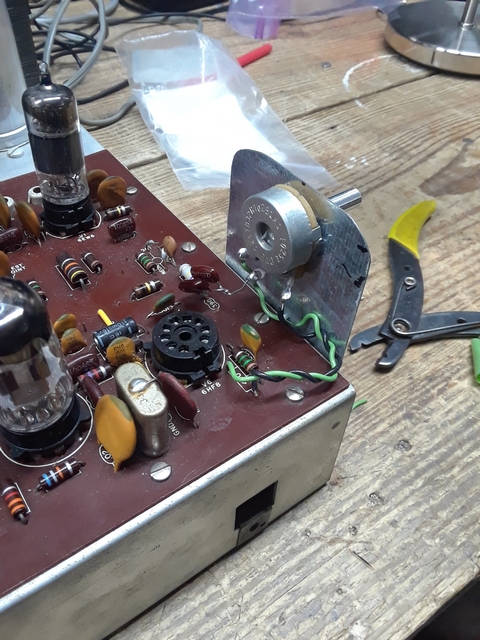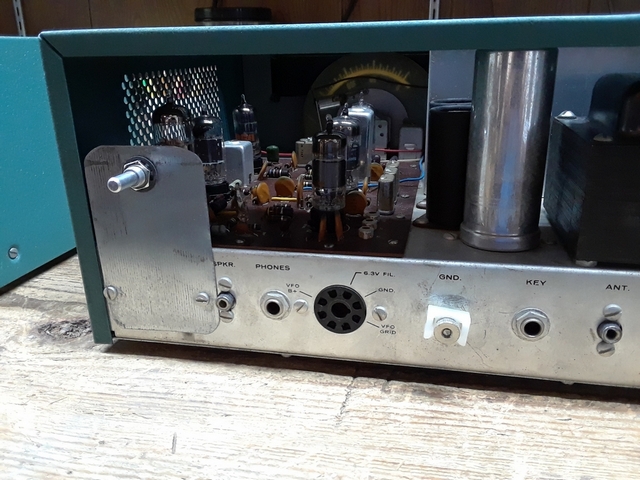
Restored for Ken N3CU of Quarryville PA.

What more can be said! The Heathkit HW-16 and HG-10B are one of amateur radio's most classic pairs. While they are fun and straightforward to work on they can toss a few curve balls at you during the restoration process. There are numerous web sites that document known issues and modifications. Here are some notes as to some of the interesting things I 've run across on the HW-16 and HG-10B.
One HW-16 would not produce any output on 15M, yet normal output was generated on 40M and 80M. This was only with the VFO; if I used a 40M crystal I was able to get between 20 and 25 watts out on 15M.
What I found was that if I removed the Oscillator and Driver tube shields I'd get 20 watts or so output on 15M using the HG-10B. If I put the tube shield on either or both of those tubes, the output dropped to 1 watt or so. 40M and 80M were unaffected. So, here's what I went through.
I performed a partial transmitter alignment as per the HW-16 manual (those steps where L8 through L11 were adjusted). When this was done I got 40 to 50 watts out on 40M and 80M, and about 20W on 15M. I then noticed I did this alignment with the Oscillator and Driver tube shields removed. I put them on and 15M output went to almost nothing.
I again performed the partial transmitter alignment with the shields on the Oscillator and Driver tubes. I got the expected output on all three bands. I noted that the alignment positions were not the same for coils L9 through L11.
I replaced the HW-16's bottom cover..... and 40M output dropped to 10W. 80M and 15M were unaffected.
I then carefully peaked L9 through L11 for maximum power output, and ended up with 15 to 20 watts out on 15M and 40 to 50 watts out on the other bands.
The HW-16 worked fine when I changed over to the VFO.
Earlier versions of the HG-10B had RFC 1 at 28 uH. To remedy low output on some bands, Heathkit changed this to 350 uH. I had a 336 uH choke in the parts pile and it worked fine. One of the guys on the Heathkit reflector said he used a 1.1 mH choke.
Note that changing this part did not impact the HW-16's low power output on 15M as describe above.
The air variable capacitor (C1 and C2) needs to be fully meshed at the low end of the band. Mine was close, but not fully meshed. With the VFO set at the bottom of the band, slowly turning the VFO to increase frequency caused the resulting VFO signal to decrease, then eventually increase as the capacitor passed through full mesh. This manifested itself in the VFO being 20 to 30 Kc off on the main tuning dial while the bottom dial frequency was correct and the upper dial frequency was (mostly) correct. Making sure the capacitor was fully meshed before alignment now caused the dial to be off only by about 5 Kc across the band.
Looking at bottom of the HG-10B with the top of the VFO facing upwards, note the shaft coupler that goes through the upper metal shield near the variable capacitor. It is natural to try and position the coupler so it is midway under the shield. This will result in the lower set-screw to be very near, or directly on, the junction of the two shafts. Nasty backlash will result! To solve this, position the coupler as far back as possible (towards the rear of the VFO) while still being able to access the top set-screw.
40-803: 15M Driver Coil L9: 2 uH
40-802: 40M Driver Coil L10: 8 uH
40-801: 80M Driver Coil L11: 60 uH
Thanks to Tom K3TVC for providing these values.

As any HW-16 operator will tell you, the stock side tone will wake the dead.... in the Milky Way and Andomeda galaxies.
While that is of course hyperbole, there's a very good chance that you will indeed get the attention of your wife, and not in a good way, if you use the stock side tone within say 5 miles of where she's sleeping.
There are a few ways to approach this, all of them easily found on the web. I chose to replace R66 with a 2K Pot that has the center
arm fed by C-84. The pot is mounted on the back panel.
You can of course use a smaller pot, but I made do with what I had in the parts pile and some scrap furnace duct sheet metal.

|

|
Copyright (c) Mark S. Bell 2020